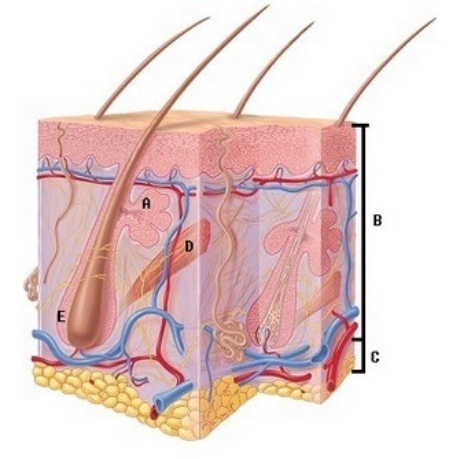A) The growth rate of all types of hair is the same.
B) Hair growth occurs in cycles, with growth and resting stages.
C) In pattern baldness, those hair follicles present begin to produce vellus hair.
D) Some loss of hair is normal and indicates old hairs are being pushed out by new hairs.
E) Genetic factors and testosterone cause pattern baldness.
Correct Answer

verified
Correct Answer
verified
Multiple Choice
Describe the effect of exposure to UV rays on the skin.
A) Decreased cancer risk
B) Increased melanin synthesis
C) Improved skin tone
D) Increased vitamin B production
Correct Answer

verified
Correct Answer
verified
Multiple Choice
The layer of the epidermis in which there is the greatest amount of mitotic activity is the ________.
A) stratum basale
B) stratum spinosum
C) stratum granulosum
D) stratum lucidum
E) stratum corneum
Correct Answer

verified
Correct Answer
verified
Multiple Choice
A subcutaneous injection delivers medication into the ________.
A) epidermis
B) dermis
C) subcutaneous layer
D) muscle
E) joint
Correct Answer

verified
Correct Answer
verified
Multiple Choice
A genetic disease characterized by the inability to produce melanin is ________.
A) psoriasis
B) albinism
C) dermatitis
D) melanoma
E) cyanosis
Correct Answer

verified
Correct Answer
verified
Multiple Choice
The nail is composed of cells of the ________.
A) stratum corneum
B) stratum lucidum
C) stratum basale
D) stratum spinosum
E) All of the choices are correct.
Correct Answer

verified
Correct Answer
verified
Multiple Choice
Due to the contraction of smooth muscle in the walls of the dermal blood vessels,
A) the blood vessels become dilated.
B) body heat is conserved.
C) more blood enters into the heart.
D) body temperature tends to drop in that area.
E) more blood flows to the skin.
Correct Answer

verified
Correct Answer
verified
Multiple Choice
Nails
A) protect the ends of digits.
B) alternate between growing and resting stages.
C) grow from their free edges.
D) are part of the dermis.
E) are soft keratin.
Correct Answer

verified
Correct Answer
verified
Multiple Choice
Which of the following skin changes is usually associated with aging?
A) Skin becomes thicker.
B) There is an increase in the number of elastic fibers in the skin.
C) Loss of subcutaneous tissue contributes to sagging of the skin.
D) Localized increase in sebaceous glands leads to dry skin.
E) The amount of collagen in the dermis increases.
Correct Answer

verified
Correct Answer
verified
Multiple Choice
Which durable protein is found in the nails, hair, and epidermis?
A) Melanin
B) Keratin
C) Carotene
D) Elastin
E) Collagen
Correct Answer

verified
Correct Answer
verified
Multiple Choice
Which of the following statements concerning hair structure is true?
A) Both the hair root and hair shaft contain living cells.
B) Undamaged hair follicles can help regenerate damaged epithelium.
C) The hair follicle has a hypodermal root sheath.
D) The matrix forms the hair surface.
E) The hair follicle is not associated with sebaceous glands.
Correct Answer

verified
Correct Answer
verified
Multiple Choice
Which of the following functions is associated with the skin?
A) Lipid production
B) Vitamin C production
C) Regulation of body pH
D) Protection against ultraviolet radiation of the sun
E) Vitamin A production
Correct Answer

verified
Correct Answer
verified
Multiple Choice
Lead poisoning can be detected by doing an analysis of ________.
A) sweat
B) skin folds
C) nails
D) hair
E) skin
Correct Answer

verified
Correct Answer
verified
Multiple Choice
The portion of the hair that extends above the surface of the skin is the ________.
A) shaft
B) cuticle
C) hair bulb
D) medulla
E) root
Correct Answer

verified
Correct Answer
verified
Multiple Choice
This condition is characterized by a thicker-than-normal stratus corneum producing large silvery scales.
A) Psoriasis
B) Decubitus ulcer
C) Bullae
D) Vitiligo
E) Eczema
Correct Answer

verified
Correct Answer
verified
Multiple Choice
 -What does structure "C" represent on the diagram?
-What does structure "C" represent on the diagram?
A) Hair follicle
B) Arrector pili
C) Epidermis and dermis
D) Subcutaneous tissue
E) Sebaceous gland
Correct Answer

verified
Correct Answer
verified
Multiple Choice
The stratum basale
A) is easily shed when you rub your hands together.
B) has a mixture of living and dead cells-mostly dead.
C) contains many blood vessels that nourish the epidermis.
D) contains cells that undergo mitosis to form new epidermal cells.
E) contains cells that undergo meiosis to form new epidermal cells.
Correct Answer

verified
Correct Answer
verified
Multiple Choice
Delicate unpigmented hairs that cover the fetus in early development are called ________ hairs.
A) terminal
B) primary
C) lanugo
D) vellus
E) secondary
Correct Answer

verified
Correct Answer
verified
Multiple Choice
The contraction of the arrector pili
A) pulls the follicle into a more perpendicular position in relation to the skin surface
B) pulls the follicle into a more oblique angle in relation to the skin surface
C) does not affect the position of the hair relative to the epidermis.
Correct Answer

verified
Correct Answer
verified
True/False
The subcutaneous tissue is part of the skin and the integumentary system.
Correct Answer

verified
Correct Answer
verified
Showing 141 - 160 of 175
Related Exams